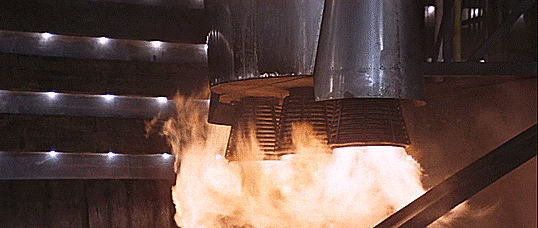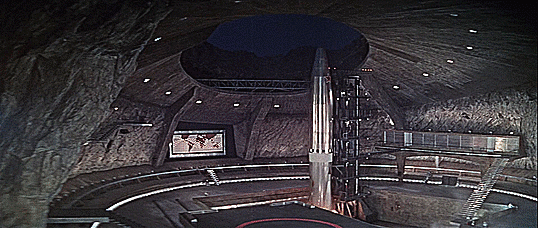#Reusable Rocket
Explore tagged Tumblr posts
Video
youtube
ESA's Airbus Reusable Rocket: The Adeline
17 notes
·
View notes
Text
BREAKING: SpaceX Nails Another Booster Landing! (Second Successful Catch!)
SpaceX has done it again! Watch the incredible footage of their second successful booster landing and catch. This groundbreaking achievement marks another milestone in reusable rocket technology.
youtube
#SpaceX#Rocket Landing#Booster Landing#Space#Technology#Innovation#Space Exploration#Engineering#Precision#Reusable Rocket#Cost Effective#Sustainability#Youtube
0 notes
Text
SpaceX's Rocket Booster Catching Success: A New Horizon in Space Exploration
SpaceX is continuously setting milestones in space exploration and technology. Recently, they achieved the remarkable feat of catching a rocket booster, the first time in the history of space exploration. Let's explore why this event is so significant and the technological challenges behind it.
youtube
Reusing Rocket Boosters: Challenges and Success
The rocket booster is the part that propels the main section of the spacecraft, carrying astronauts or cargo, beyond Earth's atmosphere. Typically, NASA’s rocket boosters detach and fall into the ocean. This process requires a specialized dive team to retrieve the boosters, disassemble them, refurbish them, and reload them with propellant. This entire procedure is time-consuming and expensive.
SpaceX brought a solution to this problem. They developed a technology that allows their rocket boosters to turn around and land precisely in designated landing zones. This was already a major advancement, but it came with numerous challenges.
Why Is This Success So Significant?
SpaceX’s achievement is not just about reusing rocket boosters; it represents a major shift in the future of space exploration. While agencies like NASA have to build new rocket boosters for every launch, SpaceX has found a way to reuse them. This not only reduces costs but also shortens the time required for space missions.
At the core of this success is their Starship rocket, known as the largest rocket ever built. For the first time, SpaceX has created a booster that returns to its launch site after takeoff and lands precisely in the giant metal arms designed to catch it. This makes the booster reusable, preparing it for future space missions.
SpaceX's Technological Advancements
SpaceX’s rocket technology is a game changer, not only in terms of reuse but also in improving the quality and success rate of space missions. They have developed a system that allows rocket boosters to return from space and be reused for further launches. This puts SpaceX far ahead of other space agencies.
The Future of Space Exploration
SpaceX’s success will help reduce the cost of space exploration and shorten mission timelines. In the future, reusable rocket booster technology will play a crucial role in space exploration. This milestone could be essential for future Mars missions and explorations of other planets. SpaceX is paving the way for humanity to one day live on other planets.
Additionally, this success could open up new possibilities for space tourism. As costs decrease and technology advances, space travel may become accessible not only to scientists but also to ordinary people. This will mark the beginning of a new era in space exploration and create a new chapter in human history.
Conclusion
SpaceX’s achievement of catching a rocket booster is not only a milestone in space research but also a significant advancement in global science and technology. This could redefine the future of space missions and become a major step towards humanity’s dream of living beyond Earth. We eagerly await more breakthroughs from SpaceX that will further enhance our understanding of space and lead humanity into the next frontier of exploration.
Watch More: The Unbeatable Security of the U.S. President’s Car: “The Beast”
Tags:
SpaceX, rocket booster, space exploration, Starship, Elon Musk, space technology, reusable rocket, NASA, space travel, future of space missions, science, technology
#SpaceX#rocket booster#space exploration#Starship#Elon Musk#space technology#reusable rocket#NASA#space travel#future of space missions#science#technology#Youtube
0 notes
Photo


(via How SpaceX Can Re-Launch the Super Heavy Rocket Within an Hour of Its Return: A Technological Marvel Redefining Space Travel)
SpaceX has always pushed the boundaries of innovation and exploration. With the Super Heavy rocket, the company has taken yet another leap towards revolutionizing space travel. One of the most remarkable capabilities of SpaceX's Super Heavy rocket is its ability to re-launch within an hour of its return. This incredible feat is set to redefine space missions and their efficiency.
https://trendingtoday2302.blogspot.com/2024/10/how-spacex-can-re-launch-super-heavy.html
#SpaceX#spaceX heavy rocket#Super Heavy rocket's reusability#Reusable rocket#Raptor engine#Elon Musk#Starship spacecraft
1 note
·
View note
Text
Elon Musk's Starship booster captured in a world first
Elon Musk's Starship booster captured in a world first #ElonMusk #FAA #Moonlandings #NASA #reusablerocket #SpaceX
1 note
·
View note
Text








Bird One, redressed as a soviet spacecraft, You Only Live Twice (1967)
#You Only Live Twice#Bird One#Rocket#Spaceship#Orbiter#Spacecraft#reusable orbiter#science fiction#scifi#1960s#1967#filmedit#filmgif#60sedit#scifiedit#bondedit#jamesbondedit#youonlylivetwiceedit#GIF#my gifs#You Only Live Twice Rewatch#Bond a Thon#Bond-a-Thon#Hide and Queue
148 notes
·
View notes
Text

X-34 Technology Testbed Demonstrator.
Date: April 16, 1999
NASA ID: EC99-44976-34
#Orbital Sciences X-34#X-34#Spaceplane#Reusable Launch Vehicle#NASA#cancelled#suborbital reusable-rocket technology demonstrator#Advanced Space Transportation Program#ASTP#April#1999
66 notes
·
View notes
Text

the early days
13 notes
·
View notes
Text




#Elon Musk#SpaceX#Starship#rocket#booster#mechazilla#space#technology#starbase#mechanical arms#chopsticks#robotic arms#launch pad#hugs#space achievement#rocket reusability#engineering marvel#Super Heavy booster#space travel#mid air
7 notes
·
View notes
Note
so uh, as per this post (https://www.tumblr.com/x-cetra/701145314915205120) this makes it sound like gary larson is your dad??
Alas no, he lacks Larson's sense of humor. My poor old dad has the type of engineer's brain that is so enmeshed in numbers he asked me, "How many people were there?" when I told him I had a tea party for my 21st birthday.
My dad is a retired rocket scientist.
#what#someone who has missed me ranting about johnny come lately elon musk pretending he invented the commercial aerospace industry#with all those exploding rocket tests that look like glitches other companies worked out in the sixties#but woo hoo he managed to get small boosters to land back on the launch pad for a made for Youtube/Twitter video#before dropping Dragon in the ocean like other companies with reusable stages were doing 40-50 years qgo#it made me appreciate my boring dad and all of his boring colleagues a lot more#Who were in the industry long before it was sexy
6 notes
·
View notes
Link
Astronomy Daily - The Podcast: S03E241 Welcome to Astronomy Daily, your trusted source for the latest in space exploration and astronomical discoveries. I'm your host, Ana, and today we have an intriguing lineup of stories that span Europe's space advancements, lunar mysteries, and groundbreaking theories in astrophysics. Highlights: - European Space Industry Developments: Discover the latest milestones in Europe's space sector, including the successful maiden launch of the Ariane 6 rocket and the triumphant return of the Vega C rocket. Learn about the innovative strides by emerging players like High Empulse and Orbex, and the trend toward reusability led by PLD Space. - Constellation Resource Unveiled: Explore a new digital collection of high-resolution images of all 88 constellations, a collaboration between NSF's NOAR Lab and the European Space Agency. This interactive all-sky map offers educational insights and stunning visuals for stargazers. Check it out here: https://noirlab.edu/public/education/constellations/ - China's Chang'e 6 Lunar Discoveries: Delve into the surprising findings from China's lunar mission, revealing a surge in the Moon's magnetic field strength 2.8 billion years ago. These insights challenge previous assumptions about lunar evolution and highlight the Moon's dynamic history. - Solving the Black Hole Information Paradox: Learn about a potential solution to the black hole information paradox, proposed by researchers at Caltech. Discover how quantum connections might preserve information about matter that falls into black holes, offering a bridge between gravity and quantum mechanics. - Satellite Defense Proposal: Investigate United Launch Alliance's plans to enhance their Vulcan Centaur rocket into a rapid response space defense system. This proposal aims to protect U.S. Space Force satellites with a focus on minimizing space debris. For more cosmic updates, visit our website at astronomydaily.io. Sign up for our free Daily newsletter to stay informed on all things space. Join our community on social media by searching for #AstroDailyPod on Facebook, X, YouTube, YouTubeMusic, Tumblr, and TikTok. Share your thoughts and connect with fellow space enthusiasts. Thank you for tuning in. This is Ana signing off. Until next time, keep looking up and stay curious about the wonders of our universe. 00:00 - Astronomy Daily explores major developments in Europe's space industry this year 02:29 - A new digital atlas brings together all 88 officially recognized constellations 04:39 - Scientists find evidence of unexpected surge in lunar magnetic field strength 2.8 billion years ago 06:48 - New study may have uncovered a solution to the black hole information paradox ✍️ Episode References Arianespace [Arianespace](https://www.arianespace.com/) High Empulse [High Impulse](https://www.highimpulse.de/) Orbex [Orbex](https://orbex.space/) PLD Space [PLD Space](https://pldspace.com/) NSF's NOIRLab [NOIRLab](https://noirlab.edu/public/) Eckhard Slawic [Eckhard Slawic](https://www.astrofotografie-slawik.com/) International Astronomical Union [IAU](https://www.iau.org/) Chinese Academy of Sciences [Chinese Academy of Sciences](http://english.cas.cn/) Caltech [Caltech](https://www.caltech.edu/) United Launch Alliance [ULA](https://www.ulalaunch.com/)
#ariane6#astrodailypod#astronomy-news#atlas#constellation#digital#european#history#hybrid#industry#lunar#magnetic#orbex#proxima#reusable#rocket#rockets#space#technology#vega-c
0 notes
Video
youtube
ReNova SSTO Rocket Concept Developed by Martin
5 notes
·
View notes
Text
Key Growth Drivers in the Space Launch Services Industry

The space industry is witnessing remarkable transformations, and space launch services are at the core of this revolution. The Space Launch Services Industry is projected to reach a staggering USD 29.6 billion by 2027, growing at a CAGR of 15.1% during the forecast period. This growth is fueled by increasing demand for satellite launches across multiple sectors, including commercial, military, and governmental applications.
As the space economy expands, new technologies, such as reusable rockets, miniaturized satellites, and flexible launch vehicles, are emerging, making space exploration more accessible and cost-efficient. This blog delves into the fundamentals of Space Launch Services, exploring how the market works, what drives its growth, key opportunities, and challenges, as well as providing an overview of the major market Key Players and recent advancements.
What Are Space Launch Services?
Space launch services encompass all activities involved in sending payloads, such as satellites, space probes, cargo, and even humans, into space. A typical space launch service includes a variety of components: from building and preparing the rocket or launch vehicle, managing ground-based launch operations, integrating payloads, to post-launch services, including satellite deployment and orbit management.
In recent years, private companies, in addition to government agencies, have begun to dominate the space launch services market. Key players like SpaceX and Rocket Lab have developed reusable launch vehicles, reducing the cost per launch and enhancing the frequency of space missions.
Key Components of Space Launch Services:
Launch Vehicle: The rocket that carries the payload into space.
Ground Control Systems: Facilities that track and control the launch vehicle during its flight.
Payload: The cargo, whether satellites, scientific instruments, or crewed modules, being carried to space.
Mission Integration: Ensuring that the payload is securely fitted and compatible with the launch vehicle.
How Do Space Launch Services Work?
Space launch services typically involve a multi-phase process:
Design & Development of Launch Vehicles: Spacecraft manufacturers design rockets with capabilities tailored to customer requirements, including payload type, orbit, and mission timeline.
Mission Planning: Launch service providers, together with clients, select the appropriate launch window, trajectory, and other mission parameters.
Payload Integration: The payload is integrated with the launch vehicle, ensuring that it is securely fastened and that all systems work harmoniously.
Launch Operations: On launch day, the ground control systems monitor the launch vehicle, guiding it to the correct trajectory.
Post-Launch Services: These include satellite deployment, monitoring, and managing the payload's position and performance in orbit.
Download PDF Brochure: https://www.marketsandmarkets.com/pdfdownloadNew.asp?id=132122845
Space Launch Services Market Growth Drivers
Several factors contribute to the rapid growth of the space launch services market:
1. Growing Demand for Small Satellites
Small satellites, or smallsats, are increasingly popular for applications such as Earth observation, communications, and research. Their reduced size and weight lead to lower launch costs, making them an attractive option for both governmental and commercial users.
2. Technological Advancements in Launch Vehicles
Innovations like reusable rockets, pioneered by companies like SpaceX, have made space launches more affordable and sustainable. Reusability reduces the need to build new rockets for every mission, significantly lowering costs and accelerating the pace of launches.
3. Increased Government and Military Investments
Governments and military organizations worldwide are increasing their investments in space exploration and satellite deployment. For example, the U.S. Department of Defense has intensified its satellite programs to enhance global communication, navigation, and surveillance capabilities.
4. Commercialization of Space
The rise of private companies in the space industry has led to increased competition, which in turn has lowered costs and spurred innovation. Commercial space missions are now more frequent, and private enterprises are launching satellites for various purposes, including broadband internet (like SpaceX’s Starlink).
Space Launch Services Market Opportunities
The future of space launch services presents several exciting opportunities:
1. Miniaturization of Technology
As satellite technology continues to miniaturize, the demand for small launch vehicles increases. Smaller payloads mean more cost-effective launches, allowing businesses and governments to deploy larger satellite constellations.
2. Reusable Rockets
Reusable launch systems significantly lower the cost per launch, making space more accessible. SpaceX’s Falcon 9 rocket is a prime example of how reusable technology has revolutionized the market, enabling more frequent and cheaper space launches.
3. Private Space Exploration
Private companies are pushing the boundaries of space exploration. SpaceX’s Starship and Blue Origin’s New Glenn are designed for deep-space missions, potentially enabling humans to explore the Moon, Mars, and beyond.
4. Emerging Space Markets
Countries like India and China are making massive strides in space exploration. India’s ISRO (Indian Space Research Organisation) and China’s CNSA (China National Space Administration) are developing low-cost, reliable launch systems, contributing to the global expansion of the space launch services market.
Ask for Sample Report: https://www.marketsandmarkets.com/requestsampleNew.asp?id=132122845
Key Market Players
Several prominent players dominate the space launch services market:
SpaceX (US): Known for its reusable rockets, SpaceX is one of the leading private space companies, offering frequent launches for both government and commercial clients.
Arianespace (France): Europe’s leading space launch service provider, Arianespace specializes in deploying commercial satellites and scientific payloads.
Northrop Grumman Corp. (US): With expertise in defense and aerospace technologies, Northrop Grumman plays a crucial role in space transportation and satellite deployment.
United Launch Alliance (US): A joint venture between Boeing and Lockheed Martin, ULA provides reliable launch services for a variety of payloads, including defense and commercial satellites.
Rocket Lab (US): Focused on small satellite launches, Rocket Lab has carved a niche by offering frequent and low-cost launches for miniaturized payloads.
China Aerospace Science and Technology Corporation (China): As the largest space organization in China, CASC handles military, scientific, and commercial space missions.
Recent Developments
The space launch services industry is continuously evolving, with several recent developments pushing the boundaries of space exploration:
Rocket Lab’s Successful Launches: In March 2022, Rocket Lab successfully deployed its second Synthetic Aperture Radar (SAR) satellite for data provider Synspective. This brings the total number of satellites launched by Rocket Lab to over 110.
NASA’s Artemis Program: NASA’s Artemis program, which aims to land humans on the Moon by 2024, is working with private companies like SpaceX, Blue Origin, and Dynetics to develop lunar landers.
SpaceX’s Starship Testing: SpaceX continues to test its Starship vehicle, which is designed for deep-space exploration. Starship is expected to revolutionize space travel, with missions planned for Mars in the coming years.
Challenges in the Space Launch Services Market
While the space launch services market is expanding rapidly, there are several challenges that could potentially hinder growth:
Lack of Dedicated Launch Vehicles: Many small satellites are launched as secondary payloads, meaning they do not have control over their launch schedule or target orbit. This limits their mission effectiveness and delays deployment.
High Costs of Space Exploration: Despite advancements in reusable technologies, space exploration remains costly. The development of high-tech spacecraft and reliable launch systems requires significant investment.
Scarcity of Intellectual Assets: As more countries and companies enter the space race, the scarcity of skilled personnel and intellectual assets becomes a concern. Countries with fewer space exploration programs often struggle to find qualified personnel to run missions.
Cybersecurity Risks: As space missions become increasingly reliant on digital infrastructure, the threat of cyberattacks looms large. Protecting sensitive satellite data and launch operations from potential hackers is crucial for maintaining national security and mission success.
Frequently Asked Questions (FAQ)
What are space launch services? Space launch services encompass all activities involved in sending payloads, such as satellites or crewed missions, into space.
Which are the key players in the space launch services market? Key players include SpaceX (US), Arianespace (France), Northrop Grumman Corp. (US), United Launch Alliance (US), Rocket Lab (US), and China Aerospace Science and Technology Corporation (China).
What are the major drivers of the space launch services market? Key drivers include the increasing demand for small satellite deployments, reusable rocket technology, and rising government and military investments.
What are the key challenges in the space launch services market? Challenges include high development costs, lack of dedicated launch vehicles for small payloads, and cybersecurity risks.
To Gain Deeper Insights Into This Dynamic Market, Speak to Our Analyst Here: https://www.marketsandmarkets.com/speaktoanalystNew.asp?id=132122845
Key Takeaways
The space launch services market is projected to reach USD 29.6 billion by 2027, driven by increased demand for small satellite launches and technological advancements in reusable rockets.
North America holds the largest market share, followed by Europe and Asia-Pacific.
Key players in the industry include SpaceX, Rocket Lab, and Arianespace, which are pushing the boundaries of cost-effective space launches.
Reusable rockets and miniaturization of satellite technology offer significant growth opportunities in the space sector.
Challenges such as high costs, lack of launch vehicles, and cybersecurity threats remain.
#space launch services#satellite launch#reusable rockets#small satellites#space exploration#space launch market forecast
0 notes
Text
Mon_14Oct2024_Brief
Monday 14Oct2024 Brief: China Espionage, Korea Border Tensions, Nobel Prize for Researching Economic Disparities, & SpaceX Launch/Landing
#China #espionage #spy #spies #spying #Korea #NorthKorea #pyongyang #SouthKorea #drones #leaflets #border #tensions #Nobel #Prize #NobelPrize #Economics #Science #EconomicScience #EconomicSciences #Prosperity #Differences #Countries #Nations #SpaceX #Space #X #Starship #Booster #Rocket #Launch #Return #Reuse #Reusable
#Booster#border#china#Countries#Differences#drones#economics#EconomicScience#EconomicSciences#Elon#espionage#Korea#Launch#leaflets#musk#Nations#Nobel#NobelPrize#north#NorthKorea#prize#Prosperity#pyongyang#return#Reusable#Reuse#Rocket#science#south#SouthKorea
0 notes
Text
भारत ने लॉन्च किया पहला रियूजेबल हाइब्रिड रॉकेट, RHUMI 1, दुनिया भर में मचा तहलका; जानें क्यों है इतना खास
Mission Rhumi 2024: भारत अपना पहला रियूजेबल हाइब्रिड रॉकेट, RHUMI 1 आज (24 अगस्त) को चेन्नई के थिरुविदंदई से लॉन्च किया. यह देश के स्पेस रिसर्च प्रयासों में एक अहम मील का पत्थर है. RHUMI 1 तीन क्यूब सैटेलाइट और 50 PICO सैटेलाइट वाले पेलोड को एक सबऑर्बिटल ट्रेजेक्टरी में लेकर जाएगा. इसे तमिलनाडु स्थित स्टार्ट-अप स्पेस जोन इंडिया ने मार्टिन ग्रुप की मदद से बनाया है. RHUMI 1 में कई मॉडर्न…
0 notes
Text
Commercialization and Space Exploration: A New Human Frontier

Overview: The Inception of Space Travel
Humanity has always been fascinated by space exploration. Space has always been associated with limitless possibilities, from the first time we gazed up at the stars to the first time humans set foot on the moon. For many years, only governments and a select group of highly skilled scientists had access to space exploration. But there has been a noticeable change in recent years. Now that private businesses are entering the race, everyone's dream of space travel is getting closer to reality. This piece examines the history of space exploration, the expanding influence of private industry, and the implications for the future.
Government-Led Space Exploration in the Beginning
The Cold War, which saw bitter rivalry between the US and the USSR, is when the history of space exploration first emerged. The space race began in 1957 with the Soviet Union's launch of Sputnik, the first artificial satellite. With swift succession, the US launched its own space missions, and Soviet cosmonaut Yuri Gagarin became the first person to orbit the Earth in 1961.
The successful landing of the first humans on the Moon by NASA's Apollo 11 mission in 1969 stands as the most iconic event of this era. "That's one small step for man, one giant leap for mankind," said astronaut Neil Armstrong, have come to represent the accomplishments of humanity. These missions were motivated by curiosity in science, pride in the country, and the drive to demonstrate one's superiority in technology.
Commercialization's Intensification
For a long time, space exploration was only affordable and feasible for governments. There was a lot of risk involved and this was cutting edge technology. But as technology developed, prices began to decline, ushering in a new era marked by the commercialization of space travel.
Visionary leaders such as Elon Musk, Jeff Bezos, and Richard Branson propelled the emergence of private companies such as SpaceX, Blue Origin, and Virgin Galactic. Space travel became more accessible and economical thanks to the new concepts and advancements these companies brought to the field.
SpaceX's Function: Transforming Space Travel
Elon Musk launched SpaceX in 2002, and it's arguably the most well-known business in the space sector. Musk's ultimate goal is to colonize Mars and wants to make space travel as commonplace as flying. SpaceX has accomplished a number of landmarks that were previously unthinkable.
The Genius Wave (Download)
The Dragon spacecraft was sent to the International Space Station (ISS) by SpaceX in 2012, making it the first private enterprise to do so. They created history once more in 2020 when they launched NASA astronauts on the Crew Dragon spacecraft to the International Space Station (ISS), becoming the first private company to send humans into space.
Reusable rocket development is one of SpaceX's biggest achievements. Due to the one-time nature of traditional rockets, space missions are exceedingly costly. SpaceX has significantly lowered the cost of space travel by developing rockets that can land back on Earth and be reused, creating new opportunities for exploration and commercialization.
Blue Origin: Creating Space Travel Opportunities
Jeff Bezos of Amazon founded Blue Origin, which has a slightly different goal than SpaceX. Blue Origin is committed to bringing space tourism to reality, while SpaceX is focused on exploring other planets. "Step by Step, Ferociously" is the company motto, "Gradatim Ferociter," which embodies its methodical and unwavering approach to accomplishing its objectives.
The New Shepard rocket from Blue Origin is intended to carry tourists on suborbital flights, providing them with a stunning view of Earth from space and a brief period of weightlessness. With Bezos aboard, the company successfully finished its first crewed mission in 2021. This was a big step toward allowing the general public to experience space tourism.
Virgin Galactic: Space Travel's Origins
Founded by Sir Richard Branson, Virgin Galactic is a significant participant in the space tourism sector. The company's SpaceShipTwo spacecraft is intended to transport people on suborbital flights, providing them with an unforgettable space travel experience.
A significant turning point for the company came when Richard Branson himself was among the first passengers to board SpaceShipTwo in July 2021. Virgin Galactic wants to make space travel a reality for people who can afford it by starting frequent commercial flights.

The Advantages of Commercialization in Space
The commercialization of space has numerous advantages for society at large as well as for the participating companies. The following are some of the main benefits:
1. Reduced Prices: The cost of space missions is falling as private companies compete. This increases the accessibility of space exploration for researchers, scientists, and even travelers.
2. Innovation: New methods and concepts for space travel are introduced by private enterprises. Their emphasis on innovation, efficiency, and reusability propels technological
The Genius Wave (Download)
developments that help not just space exploration but also other sectors of the economy.
3. Economic Growth: The space sector is starting to have a major impact on the world economy. From satellite services to space tourism, it opens up new markets, spurs innovation, and generates jobs.
4. International Collaboration: There is a chance for increased cross-national cooperation as space becomes more accessible. Together, nations and businesses can explore space, exchange knowledge, and find solutions to pressing global issues like climate change and natural disasters.
5. Inspiring Future Generations: Young people are motivated to pursue careers in science, technology, engineering, and mathematics (STEM) by the accomplishments of private space companies. This contributes to the development of a workforce that will be able to handle important problems like space exploration in the future.
The Commercialization of Space Faces Difficulties
Although the commercialization of space has numerous advantages, there are also major obstacles to overcome:
1. Space Debris: The quantity of debris in space is growing as more businesses launch satellites and spacecraft. Other satellites and spacecraft are at risk from space debris, which could result in collisions and damage.
2. Legal and Regulatory Issues: International laws and regulations have not kept up with the space industry's explosive growth. Unresolved issues include property rights in space, responsibility for mishaps, and the militarization of space.
3. Environmental Concerns: The use of hazardous materials and carbon emissions from rocket launches and spacecraft production have an impact on the environment. These environmental issues will need to be addressed as space travel becomes more widespread.
4. Accessibility and Inequality: Although space travel is getting closer to becoming a reality, only the wealthy can afford it. Space runs the risk of turning into a playground for the wealthy, escalating already-existing disparities.
5. Ethical Issues: The prospect of settling other worlds presents moral dilemmas regarding our obligation to those ecosystems. as well as any possible effects on living things already in existence.
Space Exploration and Commercialization's Future
It's very exciting to see what space exploration and commerce will bring. The private sector is
The Genius Wave (Download)
contributing to the rapid pace of innovation and the daily emergence of new opportunities. Here are a few prospective developments to be aware of:
1. Mars Colonization: Within the next few decades, SpaceX's audacious plan to establish a human colony on Mars may come to pass. This would represent a significant milestone in human history and present new opportunities for extraterrestrial exploration and survival.
2. Space Travel for Everyone: As costs come down and technology improves, more people may be able to afford space travel. Businesses like Virgin Galactic, SpaceX, and Blue Origin are laying the groundwork for this emerging sector of the economy and enabling regular people to enjoy the wonders of space travel.
3. Space Mining: It's becoming more feasible to imagine mining asteroids for precious materials like metals, minerals, and water. Businesses such as Planetary Resources are investigating the possibilities of space mining, which has the potential to transform terrestrial industries and supply vital resources for upcoming space expeditions.
4. Lunar Bases: NASA and other space organizations are organizing missions to build long-term lunar bases. These bases might act as stepping stones for future Mars research. and beyond, offering a venue for academic study and business endeavors.
5. Developments in Satellite Technology: Communication, navigation, weather forecasting, and environmental monitoring all depend heavily on satellites. We may anticipate seeing ever more sophisticated and powerful satellites as the space industry develops, which will enhance our knowledge of and capacity to safeguard Earth.

In summary: A New Humanity in an Era
Humanity is entering a new era with the exploration and commercialization of space. Thanks to the efforts of private companies and forward-thinking leaders, what was once the domain of science fiction is now becoming a reality. There are countless options, from visiting far-off planets to enabling universal access to space travel. But as we travel farther into space, we also need to deal with the difficulties and moral issues that with this novel frontier.
Space has a bright future ahead of it, with probably unheard-of breakthroughs in technology, exploration, and universe understanding over the next few decades. Space exploration will inspire and enhance life on Earth while also benefiting those who travel beyond our planet as we continue to push the envelope of what is feasible.
The Genius Wave (Download)
#Space Tourism#Reusable Rockets#Mars Colonization#SpaceX Starship#Lunar Gateway#Future of Space Exploration#SpaceX and Innovation#Space Startups#Ethics of Space Colonization#Private vs. Government Space Missions
0 notes